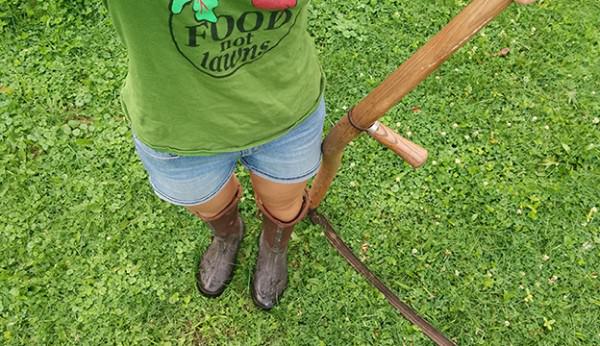
Scythes are no longer the domain of Grim Reaper costumes. They are returning to favor as farm tools for small-scale farmers and homesteaders wanting to move away from gas-powered machines. Scythes can be used in any weather, require no fossil fuels, and can last a lifetime. They offer flexibility for orchardists looking to maintain weeds close to their trees, livestock owners wanting to mow under electric fences, and families with small meadows that require infrequent brush mowing—but they can be a big help on city plots, as well.
A scythe is a long, sharpened long blade attached to a long, bent, wooden handle, called a snath. According to the Scythe Association of Britain and Ireland, the scythe originated in Europe as a curved adaptation of a sickle-style machete. Due to the curvature of the snath, a scythe is useful for mowing grasses close to the ground and harvesting grains, such as rye, wheat and barley. It is predominantly found in countries that grow pasture for livestock and grains, including Europe, the Middle East, and America.
Finding a Scythe
Many people begin with a borrowed, gifted or thrifted scythe to practice the technique before investing in the precise scythe they desire. This is a great idea if you can find a scythe to use because scything isn’t for everyone and purchasing a new scythe will cost between $175 to $250.
Blade type and snath size are the two defining factors to consider when buying a scythe. Blades are generally categorized as either grass or brush. Long, thin blades cut grass easily and efficiently, while brush requires a stouter, thicker blade. Some companies offer a “ditch” blade that falls in between grass and brush blades in terms of heft and sturdiness. Blades are sold as either right- or left-handed.
“If no one is around to teach you, start with something stout and small (45cm) and focus on short strokes,” advises Andy Graybeal, who uses a scythe on his farm in Sugar Grove, Ohio. Shorter blades also have less surface to maintain, a process which is slow for many beginners.
Several variables exist for a scythe’s wooden handle. Best-quality snaths are made from hardwood, traditionally ash, carefully selected for light weight and sturdiness. A bent shape is most popular, providing a slight angle for optimal mowing. Shorter people may prefer a straight snath because it provides a more comfortable angle to the ground. If more than one person will be using the scythe, choose a snath of middle length with adjustable handles. Many manufacturers custom make a snath to your height, arm and leg length because a well-fitted scythe will make mowing more efficient and less straining on the body.
Using a Scythe
Rather than the straight lines of a machine mower, scythe users mow in a half-round pattern. With feet hip width apart, swing the blade in an arc, slicing through material like a knife through bread. Shuffle feet forward and continue the swinging circling motion, keeping the blade as close as possible to the ground surface. Learn to move from the hips and thighs to reduce upper-body fatigue.
The scythe blade will dull quickly, especially with woody brush. Carry a small whetstone to re-hone the edge by holding it at a slight angle to the blade and sliding across from edge to edge. Repeat this often during a mowing session, watching your fingers carefully as they are prone to be cut by the sharp blade during this process.
Practice caution when carrying and storing your scythe. If you take a work break, hang the tool from a tree branch or place it in a conspicuous place, so no one steps on the blade. Make or purchase an inexpensive canvas blade cover to further protect the blade and wandering fingers. Very few injuries occur when mowing with a scythe, but mishandling before and after can result in cuts.
Maintaining a Scythe
The most skilled element of scything is not the mowing but the peening. After long use, a scythe blade edge dulls beyond what a whetstone can hone. Peening is the technique to restore the blade’s sharpness by hammering the cutting edge so that it’s thin enough to cut effectively.
“For anyone new to scything, focus on hand-peening,” Graybeal says. “The strokes of the mower will come easy enough once you learn to peen well. Peen early and often.”
To peen a blade, you’ll need either a small anvil or hammering jig and a cross peen hammer. Mount the anvil or jig to a log block or bench vice, and hammer carefully to slightly lengthen and thin the blade, moving from the beard (the thick part of the blade near the snath) to the tip. Use delicacy to avoid cracking the blade edge, and rehone with a whetstone when you’re finished peening.
Some scythe manufacturers and experienced knife sharpeners offer peening services. While this might be a good option to restore an old or damaged blade, most scythe users choose to practice peening on their own so they’re never without a sharp scythe.
With a little practice, a scythe becomes an indispensable tool. A scythe will replace a lawn mower, weed whacker and brush hog in experienced hands with no noise, pollution or fossil fuel consumption. Join the scything revolution, and you’ll quickly see why this ancient tool is making a comeback.




